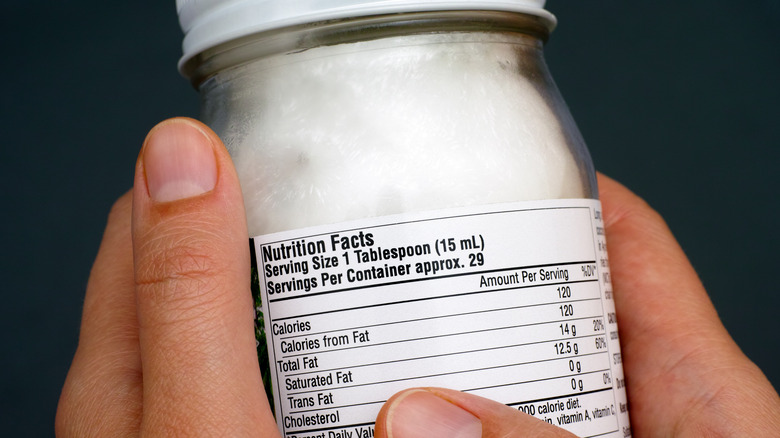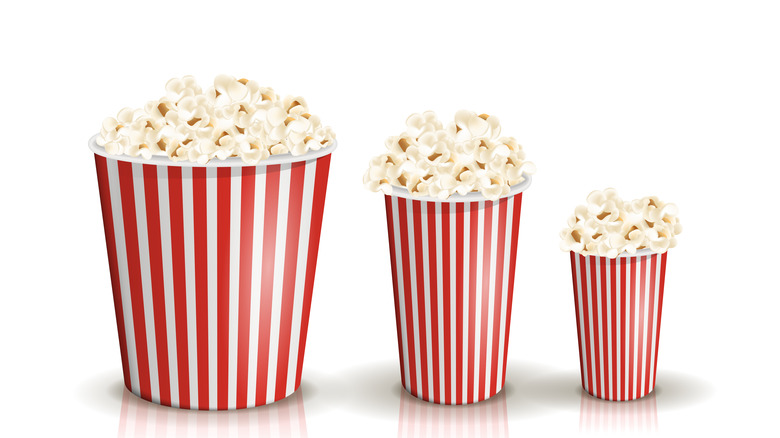How Are 'Serving Size' Labels On Food Determined?
Serving sizes can be a good way to help with portion control. When you are chowing down on a tasty snack or enjoying a sweet beverage, it can be all too easy to eat more than you originally intended, and this overeating can cause you to accidentally consume more calories, sugar, or salt than your body really needs.
Overeating can have a negative effect on one's health, including slowing down the digestive system, interfering with sleep rhythms, causing gas, heartburn, and sluggishness, and increased chance of weight gain over time, according to the MD Anderson Cancer Center. Therefore, paying attention to the serving size labels on the backs of food packages can be a helpful way to ensure you are only eating the portion of food that you really want to eat.
However, they can just as often cause some confusion. After all, it can be difficult to tell just how big a serving size is simply by looking at the back of the box. And to make matters worse, it is pretty likely that people will eat more than a single serving size of a food item when they are snacking. In fact, some recommended serving sizes might not exactly match up to the portion that the average consumer would probably dole out for themselves. So how exactly does the FDA determine what constitutes an appropriate serving size?
Serving sizes are determined using the RACC standard
Serving sizes were first introduced in 1993 by the U.S. Food and Drug Administration as part of the Nutrition Labeling and Education Act, which passed in November of 1990, according to Food Insight. The serving sizes first appeared on the backs of food as part of the nutrition facts label, which were introduced to help educate consumers about the nutritional value of their food. These labels gave consumers detailed information about the nutritional content, including the amount of calories, salt, sugar, carbs, and cholesterol in each serving size. But just how big is a serving size?
Serving sizes vary depending on the item in question, but by law, each serving size has to reflect "the amount of food people typically consume, rather than how much they should consume," according to the FDA. Therefore, sizes are determined using a standard called the Reference Amounts Customarily Consumed, or RACC. In 1977-1978 and 1987-1988, Americans were asked about their typical food consumption habits, and the RACC was determined based on the data collected from these surveys.
Because serving sizes are meant to help inform consumers, serving sizes use typical units of measurement. In some instances, it can be a standard household measurement, such as a cup or tablespoon, while for other foods it can be the portion that most people would reasonably consume in a single sitting, such as a slice or a container.
Serving sizes were updated in 2016
However, since the 1970s, the standard American diet has changed dramatically, and calorie consumption has increased by about 20 to 25 percent, according to Your Weight Matters. Therefore, the same serving sizes that were determined based on surveys conducted in the 1970s and 1980s are much less useful today than they were 30 years ago. So in 2016, serving sizes were updated in order to better reflect the "amount of a food or beverage that people typically consume during one eating or drinking occasion," according to Food Insight. These updated serving sizes were determined using more recent food consumption data: surveys that were conducted by the National Health and Nutrition Examination Surveys between 2003 to 2008, per the FDA.
In some cases, the serving sizes were also updated to more realistically reflect what a typical consumer would eat based on package size. For example, if an individual would reasonably consume an entire container of a food item, such as a can of soup or bag of chips, the new serving size would be updated to show just one single serving per package. However, it is also important to note that, even though serving sizes can help provide important nutrition information to consumers, they are still not necessarily recommended portion sizes. Rather, serving sizes are simply a tool for people to use in order to determine the appropriate portions for their own individual needs.


